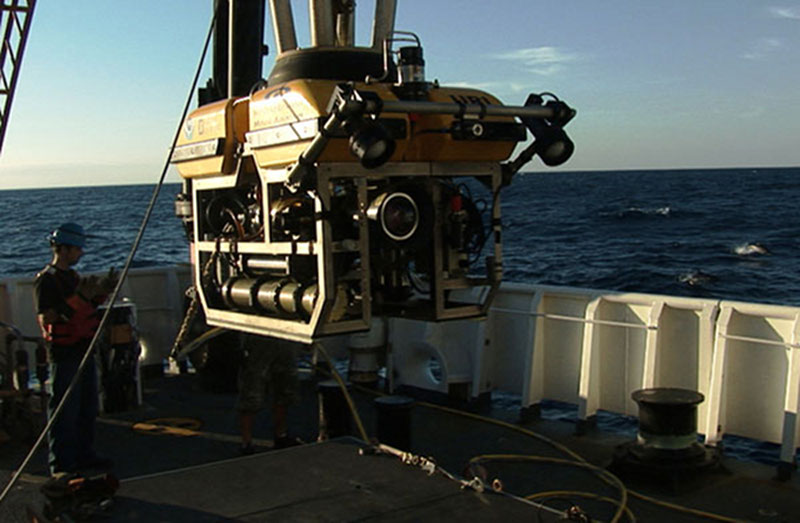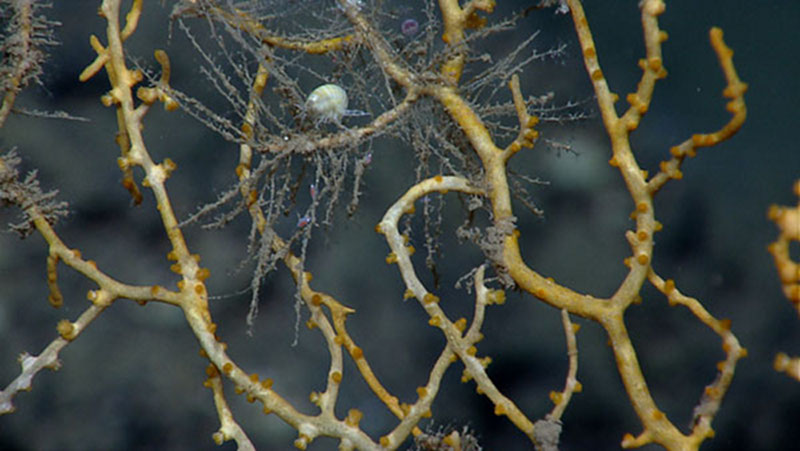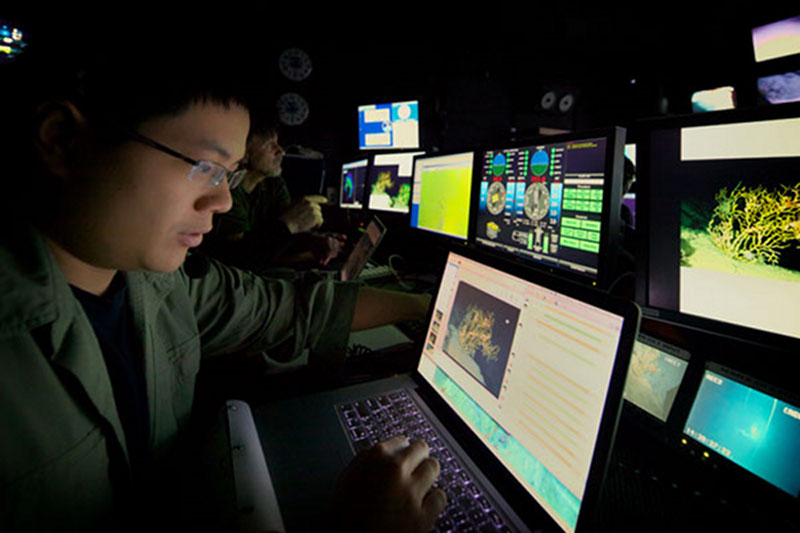
By Tim Shank, Leg II Science Team Lead - Woods Hole Oceanographic Institution
April 5, 2012

Close up image of a brittle star with arms wrapped around a paramuricid coral. The feeding side of the central disc is clearly visible in this still frame from Little Herc's high-definition camera. The coral polyps, yellow buds distributed along the branches, are retracted. The scale across the bottom of the field of view is approximately 10 centimeters. Image courtesy of the NOAA Office of Ocean Exploration and Research, Gulf of Mexico Expedition 2012. Download larger version (jpg, 1.2 MB).
Even two years following the Deepwater Horizon incident, determining the extent of exposure and types of impact to ecosystems in the deep Gulf of Mexico remains a high national priority. Unlike major oil spills that have been at the sea surface, Deepwater Horizon discharged 4.9 million barrels (or 206 million gallons) of oil discharged over 87 days, as well as 1.1 million gallons of chemical dispersants, at more than 1,400 meters depth (0.87 miles).

Little Herc’s powerful high-definition camera systems yielded unprecedented images of coral ecosystems in the vicinity of Deepwater Horizon. Image courtesy of the NOAA Office of Ocean Exploration and Research, Gulf of Mexico Expedition 2012. Download larger version (jpg, 939 KB).
Within the year that followed, more than 9,700 ships and 127 surveillance aircraft responded to the incident. Images and stories of impacted Gulf shorelines, marshes, and residents on the nightly news and the seemingly endless live broadcasts of the leaking wellhead brought into our view the impact of the spill on the ocean surface. What was unknown was the fate of the oil and dispersants at depth and the impact, if any, their release would have on deepwater ecosystems.
The current Okeanos Explorer expedition, and specifically our five dives in the vicinity of the Deepwater Horizon well location, provided an opportunity to assist with our continued national priority of assessing the potential impacts of the oil spill.

An amphipod (white upper center), a shrimp-like crustacean, here less than one centimeter in length, attached to a dead paramuricid coral branch from which hydrozoans (grey) are extending. You can also see two flea-sized amphipods (red, below the white) on a hydroid branch. Image courtesy of the NOAA Office of Ocean Exploration and Research, Gulf of Mexico Expedition 2012. Download larger version (jpg, 1.4 MB).
During a remotely operated vehicle (ROV) Jason II dive in November 2010, a 1,370-meter site containing more than 50 corals was discovered during a joint Bureau of Ocean Energy Management/NOAA Office of Ocean Exploration and Research expedition. Many of the animals showed signs of recent and significant impact. The corals appeared to be covered in a brown flocculent material and the brittle stars seemed to be discolored.
On a return visit with the human occupied vehicle (HOV) Alvin on an National Science Foundation-funded cruise in December 2010, the corals showed signs of tissue loss and excess mucous production. The brittle stars living on them similarly exhibited signs of poor health (discoloration and atrophy).
These corals and the animals associated with them, were the subject of the recent article in the Proceedings of the National Academy of Sciences article describing evidence of Deepwater Horizon oil exposure and impact to deepwater coral communities.

Pen-Yuan Hsing works diligently in the ROV Control Room to maximize the scientific benefits of the dives. Image courtesy of the NOAA Office of Ocean Exploration and Research, Gulf of Mexico Expedition 2012. Download larger version (jpg, 12.9 MB).
The unknown rate and trajectories for the potential recovery or demise of coral communities and the future assessment of the potential ramifications of the loss of these coral communities provided the motivation for our return visit to this and other sites subsequently discovered.
Between March 31 and April 5, we visited five sites in the Mississippi Canyon (MC) area (lease blocks MC294, MC297, MC388, MC255, and MC036; the Deepwater Horizon incident took place in MC252). These sites were seven miles southwest, 4.2 miles southwest, 4.7 miles southwest, 16 miles east, and 17 miles to the northeast of the well, respectively.
Using Little Herc’s high-definition camera, we documented - in great detail - more than 130 coral colonies and more than 400 associated individual animals living on them. Over the next few months, we will conduct detailed assessment of potential impact, including the change in the proportion of live to dead coral tissue on branches and observable changes in the diverse fauna living on these coral.
Working around these “delicate” corals, documenting individual branches and identifying small animals the size of fleas requires extreme precision. It is incredibly easy to inadvertently disturb these communities by suspending fine bottom sediments, contacting the corals, or altering the behavior of sometimes mobile fauna living on them. Such disruptions could impact observations.
Little Herc and the Seirios camera platform demonstrated great agility and maneuverability. Coupled with the powerful high-definition camera systems, the duo yielded unprecedented images of these coral ecosystems. This mission’s exploration through time has - and will - yield fundamental insights into how deepwater coral communities change over time (for which we almost know nothing) and provide insights into understanding impact to ecosystems in the deep Gulf of Mexico.